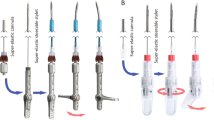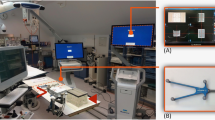Abstract
Purpose
Thermal ablation of large tumors may benefit from simultaneous placement of multiple needles, but accurate placement becomes challenging as the number of needles increases. The aim of this work was to evaluate use of personalized needle guidance grid templates based on intraprocedural CT and fabricated at the point of care to implement ablation treatment plans with multiple needles in vivo.
Methods
A plastic frame was designed to hold two parallel plastic guide plates in a rigid relationship, fixed over the abdomen by a mounting arm. Steel ball targets (1.5 mm) were implanted under ultrasound in the livers of two domestic swine under general anesthesia. Following breath-hold CT of the subject and frame, the targets and frame were identified using customized 3D Slicer-based planning software. Multiple needle trajectories targeting the balls were planned, including complex off-plane trajectories. A machining program for drilling the hole pattern corresponding to the planned needle trajectories was generated. The pattern was drilled in the two plates with a numerical-controlled milling machine in the suite. The plates were attached to the frame and needles passed through the paired holes to the calculated depth. Placement accuracy was defined as needle tip-to-target distance on post-placement CT.
Results
The planning process and manufacturing required approximately 6 and 15 min, respectively. Needles were rapidly inserted (n = 11) to the target points without complications or traversing nontarget anatomy. The mean needle tip-to-target distance error was 3.4 ± 2.2, range 0–7 mm.
Conclusion
Rapid and accurate needle placement was feasible using a subject-specific, custom-drilled, needle guidance grid template fabricated intraprocedurally. Targeting accuracy and performance were similar to more complex and expensive tracking systems which may enable accurate intraprocedural implementation of treatment plans in the liver or other organs. This may be of value in complex ablation cases or in areas where more advanced guidance systems are not available.






Similar content being viewed by others
References
Bale R, Widmann G, Haidu M (2011) Stereotactic radiofrequency ablation. Cardiovasc Intervent Radiol 34(4):852–856. https://doi.org/10.1007/s00270-010-9966-z
Bale R, Schullian P, Eberle G, Putzer D, Zoller H, Schneeberger S, Manzl C, Moser P, Oberhuber G (2019) Stereotactic radiofrequency ablation of hepatocellular carcinoma: a histopathological study in explanted livers. Hepatology 70(3):840–850. https://doi.org/10.1002/hep.30406
Schullian P, Putzer D, Eberle G, Laimer G, Bale R (2020) Simultaneous stereotactic radiofrequency ablation of multiple (>= 4) liver tumors: feasibility, safety, and efficacy. J Vasc Interv Radiol 31(6):943–952. https://doi.org/10.1016/j.jvir.2019.12.794
Venturi D, Glossop N, Bale R (2020) Patient-specific templates for image-guided intervention—a phantom study. Minim Invasive Ther Allied Technol 29(5):251–260. https://doi.org/10.1080/13645706.2019.1626251
Fedorov A, Beichel R, Kalpathy-Cramer J, Finet J, Fillion-Robin JC, Pujol S, Bauer C, Jennings D, Fennessy F, Sonka M, Buatti J, Aylward S, Miller JV, Pieper S, Kikinis R (2012) 3D slicer as an image computing platform for the quantitative imaging network. Magn Reson Imaging 30(9):1323–1341. https://doi.org/10.1016/j.mri.2012.05.001
Osian AD, Anderson LL, Linares LA, Nori D, Hilaris BS (1989) Treatment planning for permanent and temporary percutaneous implants with custom made templates. Int J Radiat Oncol Biol Phys 16(1):219–223. https://doi.org/10.1016/0360-3016(89)90034-5
Putzer D, Arco D, Schamberger B, Schanda F, Mahlknecht J, Widmann G, Schullian P, Jaschke W, Bale R (2016) Comparison of two electromagnetic navigation systems for CT-guided punctures: a phantom study. Fortschr Röntgenstr 188(5):470–478. https://doi.org/10.1055/s-0042-103691
Schullian P, Widmann G, Lang TB, Knoflach M, Bale R (2011) Accuracy and diagnostic yield of CT-guided stereotactic liver biopsy of primary and secondary liver tumors. Comput Aided Surg 16(4):181–187. https://doi.org/10.3109/10929088.2011.578367
Krucker J, Xu S, Glossop N, Viswanathan A, Borgert J, Schulz H, Wood BJ (2007) Electromagnetic tracking for thermal ablation and biopsy guidance: clinical evaluation of spatial accuracy. J Vasc Interv Radiol 18(9):1141–1150. https://doi.org/10.1016/j.jvir.2007.06.014
Forster GJ, Laumann C, Nickel O, Kann P, Rieker O, Bartenstein P (2003) SPET/CT image co-registration in the abdomen with a simple and cost-effective tool. Eur J Nucl Med Mol Imaging 30(1):32–39. https://doi.org/10.1007/s00259-002-1013-0
Hu Y, Zhou YK, Chen YX, Shi SM, Zeng ZC (2017) Clinical benefits of new immobilization system for hypofractionated radiotherapy of intrahepatic hepatocellular carcinoma by helical tomotherapy. Med Dosim 42(1):37–41. https://doi.org/10.1016/j.meddos.2016.10.005
Ueda Y, Teshima T, Cardenes H, Das IJ (2017) Evaluation of initial setup errors of two immobilization devices for lung stereotactic body radiation therapy (SBRT). J Appl Clin Med Phys 18(4):62–68. https://doi.org/10.1002/acm2.12093
Widmann G, Schullian P, Haidu M, Wiedermann FJ, Bale R (2010) Respiratory motion control for stereotactic and robotic liver interventions. Int J Med Robot 6(3):343–349. https://doi.org/10.1002/rcs.343
Widmann G, Schullian P, Haidu M, Fasser M, Bale R (2011) Targeting accuracy of CT-guided stereotaxy for radiofrequency ablation of liver tumours. Minim Invasive Ther Allied Technol 20(4):218–225. https://doi.org/10.3109/13645706.2010.533923
Acknowledgements
We thank Andras Lasso and Gabor Fichtinger of the Department of Computer Science, Queens University, for their assistance with the planning software used in this study.
Funding
This work was supported by the Center for Interventional Oncology in the Intramural Research Program of the National Institutes of Health (NIH) by intramural NIH Grants NIH Z01 1ZID BC011242 and CL040015.
Author information
Authors and Affiliations
Corresponding author
Ethics declarations
Conflict of interest
Neil Glossop is an employee of ArciTrax Inc. and has intellectual property in related fields. Reto Bale is a paid consultant for Medtronic, Siemens, and Interventional Systems. Sheng Xu reports no competing interests. William Pritchard reports no competing interests. John Karanian reports no competing interests. Bradford Wood is the Principal Investigator on a Cooperative Research & Development Agreement (CRADA) between NIH and Philips and Philips Research. Philips pays royalties to NIH for a licensing agreement with NIH, who then pays royalties to BW for licensed patents from Philips. NIH may share intellectual property with ArciTrax. Bradford Wood is the Principal Investigator on CRADAs between NIH and NVIDIA, XACT Robotics, Celsion, Siemens, and BTG/Biocompatibles (now Boston Scientific). NIH has a Material Transfer Agreements with Angiodynamics.
Ethical approval
All applicable international, national, and/or institutional guidelines for the care and use of animals were followed. This study was carried out in strict accordance with the recommendations in the Guide for the Care and Use of Laboratory Animals of the National Institutes of Health. The study protocol was approved by the Animal Care and Use Committee of the NIH Clinical Center.
Informed consent
For this type of study, informed consent is not required.
Consent for publication
For this type of study, consent for publication is not required.
Additional information
Publisher's Note
Springer Nature remains neutral with regard to jurisdictional claims in published maps and institutional affiliations.
Disclaimer The content of this manuscript does not necessarily reflect the views or policies of the U.S. Department of Health and Human Services. The mention of commercial products, their source, or their use in connection with material reported herein is not to be construed as an actual or implied endorsement of such products by the United States government.
Rights and permissions
Springer Nature or its licensor holds exclusive rights to this article under a publishing agreement with the author(s) or other rightsholder(s); author self-archiving of the accepted manuscript version of this article is solely governed by the terms of such publishing agreement and applicable law.
About this article
Cite this article
Glossop, N., Bale, R., Xu, S. et al. Patient-specific needle guidance templates drilled intraprocedurally for image guided intervention: feasibility study in swine. Int J CARS 18, 537–544 (2023). https://doi.org/10.1007/s11548-022-02747-4
Received:
Accepted:
Published:
Issue Date:
DOI: https://doi.org/10.1007/s11548-022-02747-4




